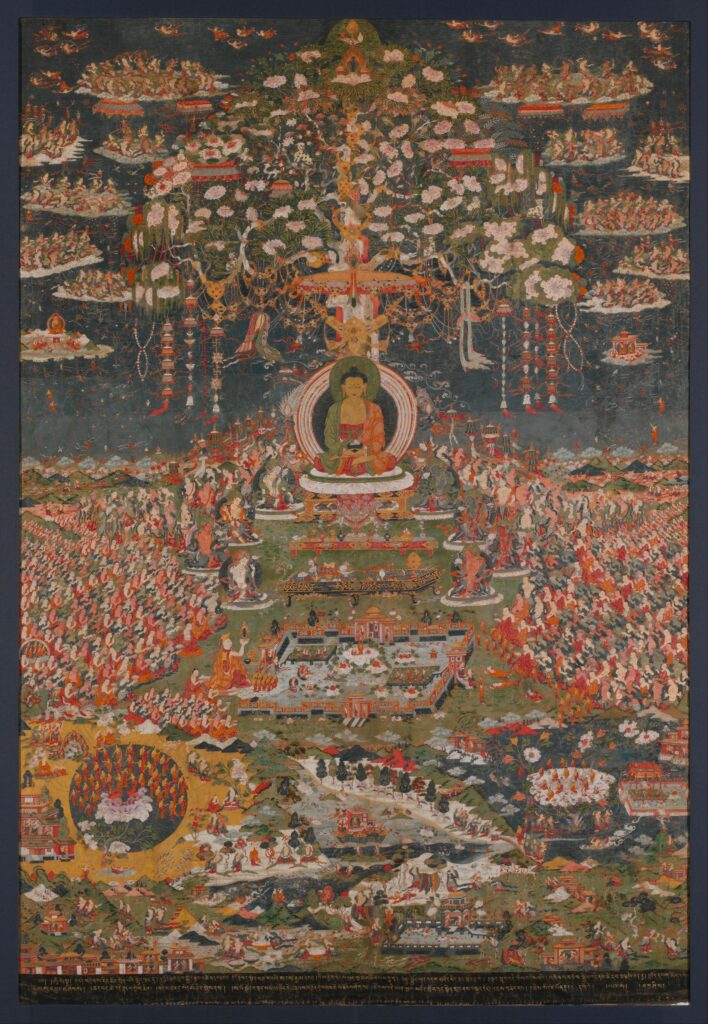Amitābha Buddha is associated with the realm of Sukhāvatī and serves as the principal buddha of the Pure Land tradition of eastern Buddhism. According to the Longer Sukhāvatīvyūha Sūtra, in a prior life as the bodhisattva monk Dharmākara, he made forty-eight original vows (praṇidhāna) to bring beings to enlightenment, thus establishing Sukhāvatī for their benefit. In Vajrayāna contexts, Amitābha in his sambhogakāya form is referred to as Buddha Amitāyus. In Vajrayāna he is also one of the five dhyāni-buddhas and is the buddha of the western direction, associated with the aggregate of perception (saṃjñāskandha). Aspiration prayers for rebirth in Sukhāvatī are regularly recited throughout Tibet.
According to modern scholarship, the earliest reference to Amitābha, and the first to instruct on the practice of calling on his name, appears in the Pratyutpannabuddha Saṃmukhāvasthita Samādhi Sūtra (usually referred to as the Pratyutpanna Samādhi Sūtra). This practice seemed to have gained great popularity quickly in China.
Bodhisattvas hear about the Buddha Amitābha and call him to mind again and again in this land. Because of this calling to mind, they see the Buddha Amitābha. Having seen him they ask him what dharmas it takes to be born in the realm of the Buddha Amitābha. Then the Buddha Amitābha says to these bodhisattvas: “If you wish to come and be born in my realm, you must always call me to mind again and again, you must always keep this thought in mind without letting up, and thus you will succeed in coming to be born in my realm.
Harrison, Paul. McRae, John. The Pratyutpanna Samādhi Sūtra and the Śūraṅgama Samādhi Sūtra. 1998. pp. 2–3, 19
Many details on Amitābha and his land of Sukhāvatī (Tib. Dewachen) are found in three extant pure realm sūtras. The Display of the Pure Land of Sukhāvatī is the shortest of these. The Tibetan Kangyur includes two of these texts: The Display, which is often called the “shorter” Sukhāvatī, and the “longer” sūtra, entitled The Array of Amitābha. The third, The Amitāyus Meditation Sūtra, is today found only in Chinese. The two larger sūtras describe the pure land as a direct result of the vows of Buddha Amitābha, who out of great compassion created a blissful realm for beings with sufficient merit to quickly progress on the spiritual path. The Display sūtra omits the vows and only describes the pure realm and its characteristics.
Sukhāvatī is a realm of happiness and delight, with no suffering. Those who are reborn there benefit from the presence and teachings of buddhas, bodhisattvas, and arhats, and engage exclusively in wholesome activities. The principal buddha there is known by two names, Amitāyus (Immeasurable Life) and Amitābha (Immeasurable Light).
In the shorter sutra, the action unfolds in the Jeta Grove of Śrāvastī. Buddha Śākyamuni, surrounded by a vast retinue of exalted beings, instructs his disciple Śāriputra on the realm of Sukhāvatī. He also explains the two names of the buddha as representing different qualities.
Now what do you think, Śāriputra, why is that tathāgata called ‘Amitāyus’ (Immeasurable Life)? Śāriputra, the lifespan of Tathāgata Amitāyus is immeasurable. For this reason, he is called ‘Tathāgata Amitāyus.’ Furthermore, Śāriputra, why is that tathāgata called ‘Amitābha’ (Immeasurable Light)? Śāriputra, the light of Tathāgata Amitābha shines unimpeded throughout all buddha realms. For this reason, he is called ‘Tathāgata Amitābha.’ The Bhagavān Tathāgata Amitābha fully awakened to unsurpassable, completely perfect enlightenment ten eons ago.
The Display of the Pure Land of Sukhāvatī, trans. by The Sakya Pandita Translation Group.
In this sutra, the Buddha instructs his listeners on the pure realm,
On that occasion, the Bhagavān said to the venerable Śāriputra, “Śāriputra, if you go from this buddha realm past 100,000 myriad buddha realms toward the western direction, there is a world known as Sukhāvatī (The Delightful). In that place the Tathāgata, the arhat, the perfectly and fully enlightened buddha known as Amitāyus (Immeasurable Life), dwells, lives, and abides, teaching the Dharma.
“Now what do you think, Śāriputra, why is that world called ‘Sukhāvatī’?
“Śāriputra, in the Sukhāvatī world, sentient beings experience neither physical pain nor mental suffering, and the causes for their happiness are limitless. For this reason, this world is called Sukhāvatī.
The Display of the Pure Land of Sukhāvatī, trans. by The Sakya Pandita Translation Group.



